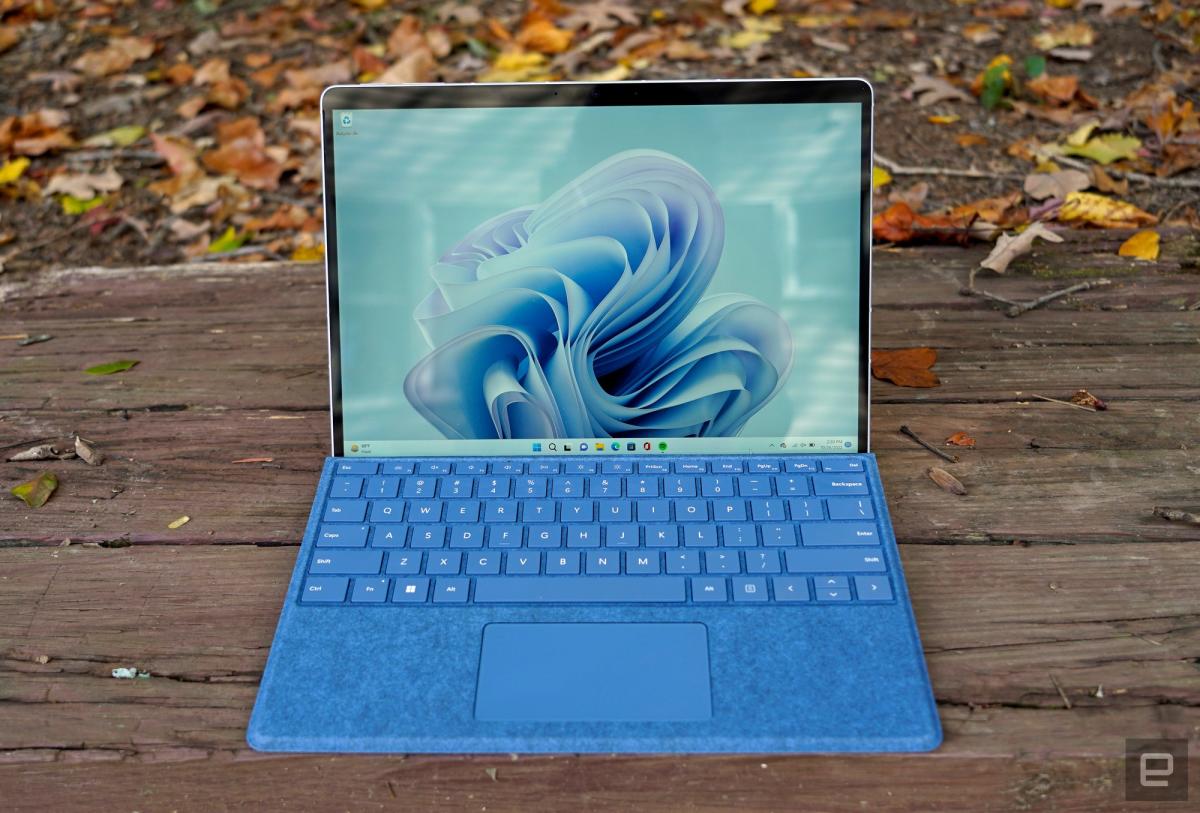
The perfect hybrid machine that’s just as good a tablet as it is a traditional laptop still doesn’t exist. But throughout last year, companies like Microsoft, Apple and Google continued to improve their operating systems for machines that do double duty. Windows 11 has features that make it friendlier for multi-screen devices, while Android has been better optimized for larger displays. Plus, with the rise of ARM-based chips for laptops, especially Apple’s impressive M series, prospects for a powerful 2-in-1 with a vast touch-friendly app ecosystem is at an all-time high.
Even the best 2-in-1 laptops still have their limits, of course. Since they’re smaller than proper laptops, they tend to have less-powerful processors. Keyboards are often less sturdy, with condensed layouts and shallower travel. Plus, they’re almost always tablets first, leaving you to buy a keyboard case separately. (And those ain’t cheap!) So, you can’t always assume the advertised price is what you’ll actually spend on the 2-in-1 you want.
Sometimes, getting a third-party keyboard might be just as good, and they’re often cheaper than first-party offerings. If you’re looking to save some money, Logitech’s Slim Folio is an affordable option, and if you don’t need your keyboard to attach to your tablet, Logitech’s K780 Multi-Device wireless keyboard is also a good pick.
While we’ve typically made sure to include a budget 2-in-1 laptop in previous years, this time there isn’t a great choice to include in our top picks. We would usually highlight a device like the Surface Go, but the latest model is still too expensive. Other alternatives, like cheaper Android tablets, are underpowered and don’t offer a great multitasking interface. If you want something around $500 that’s thin, lightweight and long-lasting, you’re better off this year looking at a conventional PC (like those on our best budget laptops list).
When you’re shopping for a 2-in-1, there are some basic criteria to keep in mind. First, look at the spec sheet to see how heavy the tablet is (alone, and with the keyboard). Most modern hybrids weigh less than 2 pounds, with the 1.94-pound Surface Pro 9 being one of the heaviest around. The iPad Pro 12.9 (2022) and Samsung’s Galaxy Tab S9 series are both slightly lighter. If the overall weight of the tablet and its keyboard come close to 3 pounds, you’ll be better off just getting an ultraportable laptop.
See Also:
You’ll also want to opt for an 11-inch or 12-inch screen instead of a smaller 10-inch model. The bigger displays will make multitasking easier, plus their companion keyboards will be much better spaced. Also, try to get 6GB of RAM if you can for better performance.
Finally, while some convertible laptops offer built-in LTE or 5G connectivity, not everyone will want to pay the premium for it. An integrated cellular radio makes checking emails or replying to messages on the go far more convenient. But it also often costs more, and that’s not counting what you’ll pay for data. And, as for 5G — you can hold off on it unless you live within range of a mmWave beacon. Coverage is still spotty and existing nationwide networks use the slower sub-6 technology that’s barely faster than LTE.
Best overall: Surface Pro 9 (Intel)
There’s no beating the Surface series when it comes to 2-in-1s – they’re powerful, sleek tablets running an OS that’s designed for productivity.
There’s no beating the great performance of the Surface series when it comes to 2-in-1s. They’re powerful, sleek tablets running an OS that’s actually designed for productivity. The Surface Pro 9 is Microsoft’s latest and great tablet, and it builds upon the already excellent Pro 8. It features speedy 12th-gen Intel CPUs and all of the major upgrades from last year, including a 120Hz display and a more modern design. It’s the best implementation of Microsoft’s tablet PC vision yet.
Don’t confuse this with the similarly named Surface Pro 9 with 5G, though, which has a slower ARM processor and inferior software compatibility. Built-in cellular is nice and all, but the Intel Pro 9 is a far better PC.
Like most of the other convertible laptops on this list, the Pro 9 doesn’t come with a keyboard cover — you’ll have to pay extra for that. That’s a shame, considering it starts at $1,000. Microsoft offers a variety of Type Covers for its Surface Pros ranging from $100 to $180, depending on whether you want a slot for a stylus. But at least they’re comfortable and well-spaced. You can also get the Surface Slim Pen 2 ($130) for sketching out your diagrams or artwork, which features haptic feedback for a more responsive experience.
Read our full review of the Microsoft Surface Pro 9
Best for Apple users: 12.9-inch iPad Pro
This iPad Pro has a stunning 12.9-inch screen with a speedy 120Hz refresh rate, as well as mini-LED backlighting, and the M2 chipset for stellar performance.
If you’re already in the Apple ecosystem, the best option for you is obviously an iPad. The 12-inch Pro is our pick. Like older models, this iPad Pro has a stunning 12.9-inch screen with a speedy 120Hz refresh rate, as well as mini-LED backlighting. This year, it includes Apple’s incredibly fast M2 chip for excellent performance and more battery life than ever before.
Apple’s Magic Keyboard provides a satisfying typing experience, and its touchpad means you won’t have to reach for the screen to launch apps. But it’ll also cost you an extra $300, making it the most expensive case on this list by a lot. The iPad also lacks a headphone jack and its webcam is awkwardly positioned along the left bezel when you prop it up horizontally, so be aware that it’s still far from a perfect laptop replacement. Still, with its sleek design and respectable battery life, the iPad Pro 12.9 makes it a good 2-in-1 choice for Apple users.
Read our full review of the Apple iPad Pro
Best for Android users: Samsung Galaxy Tab S9
Samsung’s Galaxy Tab S9 series of tablets is its best yet, and the ecosystem of smart software and accessories that accompany it make it a great choice for Android users looking for a new 2-in-1.
Samsung has consistently made the best Android tablets for years now, and the company also offers an ecosystem of accessories that make its Galaxy Tab series the best choice if you want an Android 2-in-1 device. This year’s Galaxy Tab S9 series comes in three sizes, but we think the S9+ or S9 Ultra are the best for productivity. The S9+ has a 12.4-inch display, while the Ultra steps it up to a 14.6-inch screen – both of which are among the best we’ve seen on mobile devices like this. Otherwise, the two devices are identical, with Snapdragon 8 Gen 2 processors and 12GB of RAM, both upgrades over last year’s model. And as in years past, Samsung includes its S Pen stylus for drawing and note-taking.
Android’s default multitasking experience is not as good as what you’ll find on Windows or on an iPad, but Samsung’s Dex software converts the tablet experience into something very similar to Windows. Every app is completely resizable, and you can have up to five different apps running simultaneously, with others just a click away in the taskbar.
We only reviewed the S9 Ultra, but that tablet had solid battery life when running multiple apps in Dex mode, up to about seven hours. Given that the S9+ and S9 Ultra have identical specs, we’re comfortable recommending both, though. Just pick your preferred screen size and one of the keyboard covers Samsung sells and you’ve got a solid productive device that’s thin, light and powerful.
Read our Full Review of Samsung Galaxy Tab S9 Ultra
Honorable mention: Lenovo Yoga 9i
Adaptability is the biggest strength of a 2-in-1, with devices like the Yoga 9i capable of transforming into a number of different modes at a moment’s notice.
Adaptability is the biggest strength of a 2-in-1, with devices like the Yoga 9i capable of transforming into a number of different modes at a moment’s notice. Even though it’s got a relatively portable 14-inch OLED display, Lenovo still found room on the Yoga 9i for three USB-C ports, a fingerprint scanner and a clever rotating soundbar to ensure audio sounds good in any position. Lenovo also includes a free stylus in the box but, unlike previous models, there isn’t a dedicated storage slot for it on the machine anymore. It’s also worth noting that, while its general design hasn’t changed much for 2023, Lenovo has improved the Yoga 9i’s performance with updated 13th-gen Intel processors.














